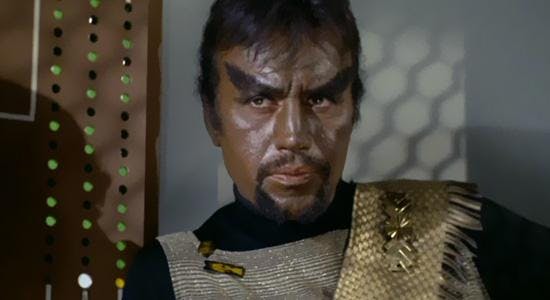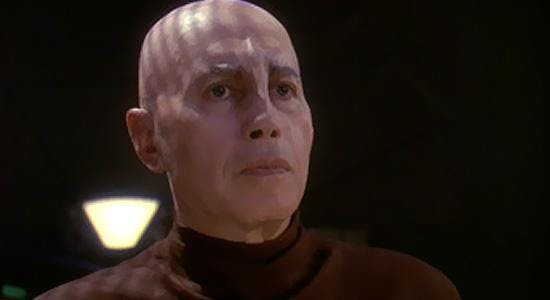Published Apr 14, 2017
Michael Ansara: Good Guys, Bad Guys & Guys in Between
Michael Ansara: Good Guys, Bad Guys & Guys in Between

Our heroes keep passing away at an increasingly alarming rate, but so too do our villains. Neither, it seems, triumphs in the end. Michael Ansara -- who would have turned 95 years old today; he died in 2013 at the age of 91 -- played both hero and villain, and some characters in between. But in reading the first two obituaries I caught in the mainstream media following his death four years ago, I was struck by the prominence that his part as Klingon Captain Kang in Star Trek's "Day of the Dove" received. It was the very first credit noted in both obits! You know, in that "Humphrey Bogart, star of Casablanca" way.

About this, I had -- and still have -- mixed feelings. On one hand, as a fan, I'm delighted by Star Trek's continuing visibility and its influence on pop culture outlasting so many formerly-fashionable entertainment phenomena. And on the other hand, well, Kang really wasn't Ansara's most important role (though, sure, it's important to us here in Trekland).

No, I'd argue, first, to consider the Westerns. Ansara was the star of two pioneering TV Westerns, portraying Cochise in Broken Arrow (1956-58, derived from an earlier Jimmy Stewart film) and Marshal Sam Buckhart in the 1959-60 series Law of the Plainsman (one of Ansara's favorite acting jobs ever). Both are all but forgotten today, having no real afterlife I'm aware of in TV Valhalla (i.e. reruns, VHS/DVD releases, replay on nostalgia networks, streaming availability). In both shows, the Syrian-born Ansara portrayed Native American protagonists in a medium whose only significant previous Indian hero had been The Lone Ranger's Tonto. "I was sort of an innovator," Ansara said in 1996. "I helped make them real, human people." Several Indian tribes across America responded by making Ansara a blood brother.

With his then-wife Barbara Eden, he took a Voyage to the Bottom of the Sea (Irwin Allen's 1961 movie that spawned the later TV series). He showed up on Lost in Space and Allen's other SF TV shows, too. Ansara also guested as the Blue Djinn (and other characters) on Eden's hit sitcom I Dream of Jeannie (even directing an episode). There were countless TV gigs (among them The Fugitive, Perry Mason, Rawhide, Hawaii Five-O, Mission: Impossible and The Untouchables). He made movies both major (as Judas Iscariot in The Robe, 1953's Julius Caesar, Harum Scarum with Elvis Presley) and minor (Abbott and Costello Meet the Mummy, The Manitou, Day of the Animals). I really liked (i.e., loathed) him as a bad guy in Guns of the Magnificent Seven and The Comancheros (facing John Wayne). He was even Killer Kane in the Buck Rogers in the 25th Century TV series (though not its movie/pilot).

To me, though, his two most pivotal performances came in black & white ("Soldier" on the original Outer Limits) and cartoon color (Batman: The Animated Series' "Heart of Ice"). Ansara was riveting as the brutal (and brutalized) Qarlo, an ultra-violent "Soldier" from tomorrow inadvertently come to our time to (perhaps) kill in the Harlan Ellison-scripted, 1964 Outer Limits classic (an admitted inspiration for The Terminator). Almost three decades later, Ansara only needed his voice to portray the cold but compelling Mr. Freeze in the acclaimed "Heart of Ice" (which won writer Paul Dini an Emmy). It offered a new take on an old Batman baddie, making Dr. Victor Fries (a.k.a. Mr. Freeze) not a villain, but a chilling figure of pathos, a lonely, maddened scientist driven to crime to implement a cure for his diseased, cryogenically frozen wife.

If that icy scenario seems familiar now, it's because the 1992 "Heart of Ice" incarnation then became DC Comics' standard for Freeze's subsequent comic book appearances. The 1997 live-action flick Batman & Robin cannibalized the characterization and some story points -- but Arnold Schwarzenegger, the once and future Terminator, did a terrible job at following Ansara in this role. Ansara also voiced Freeze in Batman cartoon spinoff programs and the 1998 direct-to-DVD animated film Batman & Mr.Freeze: SubZero.
So, considering all this, did "Day of the Dove" really deserve that obituarial honor as the most identifiable Ansara role over some of these other credits? Perhaps. Personally, I'd give it to Broken Arrow or "Soldier." You may feel differently. The New York Times, at least, in their obituary (which I read later) gave equal billing to Cochise and Kang, contrasting them as warriors from different times.

As for Klingon Captain Kang, "What a magnificent character to play!" Ansara exclaimed when Starlog interviewed him (twice, Mark Phillips in issue #138, Tom Weaver, #225). "Immediately, just from reading the script, I knew how special the role was and how rare it was to find a character like this in either television or film. Kang had nobility and that's a quality that I have always been fascinated by. People seemed to like [that 1968 segment], and I loved doing it."

Ansara reprised the role 26 years later -- along with fellow Klingons John Colicos (Kor) and William Campbell (Koloth), "a very, very close friend" -- on Star Trek: Deep Space Nine in 1994. "They [the producers] were a little worried, they thought we were rickety old men," Ansara told Weaver, "and they wondered if we could climb the stairs and do the swordfights. We sort of laughed about it."
Despite the "miserable-to-put-on" newish Klingon makeup, Ansara thought DS9's "Blood Oath" was "fun. As I understand, it turned out to be one of the best episodes." He was Kang again in Star Trek: Voyager's "Flashback" in 1996.

Ansara also returned to DS9, briefly playing another character, one of Lwaxana Troi's husbands, in "The Muse." But, I certainly agree with that critical assessment of "Blood Oath." It's bloody good. In fact, that DS9 episode is what brought the Klingons Three (Ansara, Colicos, Campbell) to the May 1995 SeaTrek Cruise, which is where I met him.
The major Trek celebs and "the little people" (minor guests like Starlog Special FX Editor David Hutchison and me) got to clamber aboard ship ahead of regular cruisegoers. "Hutch" and I soon headed to the early buffet, got plates heaping with goodies and grabbed a table portside. Not long afterward, my pals Bill and Tereza Campbell ambled by with their trays and joined us. Ten minutes later, Campbell flagged down Michael Ansara and third wife Beverly, who had been forlornly looking for a place to eat. Introductions were made by Campbell (the most extroverted guy I've ever met) and they sat down for lunch. Sorry to say but Klingon was not spoken.
Ansara seemed a little reticent, reserved, yet regal; his head, entirely shaven bald, was striking, a unique look he had apparently returned to after initially going full Picard in the 1960s for a production of The King and I.

Today, 22-plus years later, I only vaguely recall the topics of conversation (cruising, Hollywood, Trek fans, etc.). To me, Ansara appeared far more shy than the characters he had portrayed. Circumspect is really the right word to describe him. Maybe he was overwhelmed by the cruise or our mutual friend Campbell (anyone might seem shy compared to Campbell's exuberance), or perhaps merely careful while dining with strangers from Starlog.
Maybe, though, it's just me. I already knew almost all the other cruise celebs. And I admit to being a tad in awe of Ansara. After all, he had worked with Abbott & Costello, Peter Lorre and John Wayne. But, I did take the opportunity then to arrange contact info for that second Starlog interview, conducted months later by film historian Tom Weaver, so Ansara could talk to us about more than just Star Trek.
That's when Ansara declared, "I was never considered a leading man -- maybe a leading character actor," before listing his career regrets to Weaver. "You never think you do quite as much as you would like to do. I would have liked to have done more, gotten bigger, more important. But on the other hand, I had a long, long career, longer than so many people who would come, make a flash and disappear. So, I really have no complaints, and yet -- who is ever satisfied? You always would have liked to have done more."
David McDonnell, "the maitre’d of the science fiction universe," has dished up coverage of pop culture for more than three decades. Beginning his professional career in 1975 with the weekly "Media Report" news column in The Comic Buyers’ Guide, he joined Jim Steranko’s Mediascene Prevue in 1980. After 31 months as Starlog’s Managing Editor (beginning in October 1982), he became that pioneering SF magazine’s longtime Editor (1985-2009). He also served as Editor of its sister publications Comics Scene, Fangoria and Fantasy Worlds. At the same time, he edited numerous licensed movie one-shots (Star Trek and James Bond films, Aliens, Willow, etc.) and three ongoing official magazine series devoted to Trek TV sagas (The Next Generation, Deep Space Nine, Voyager). He apparently still holds this galaxy’s record for editing more magazine pieces about Star Trek in total than any other individual, human or alien.

